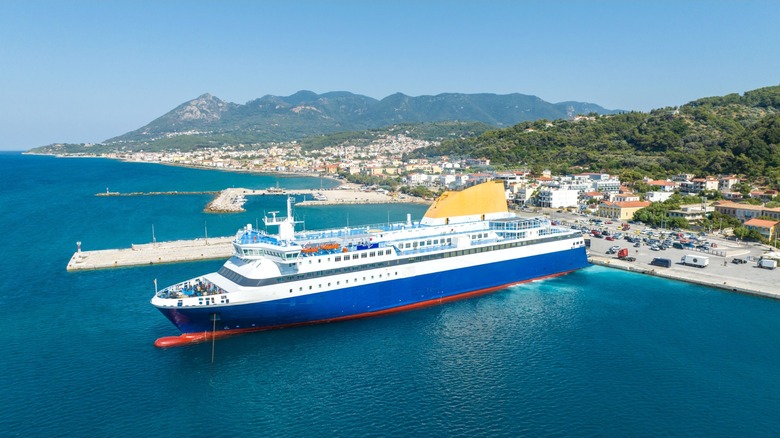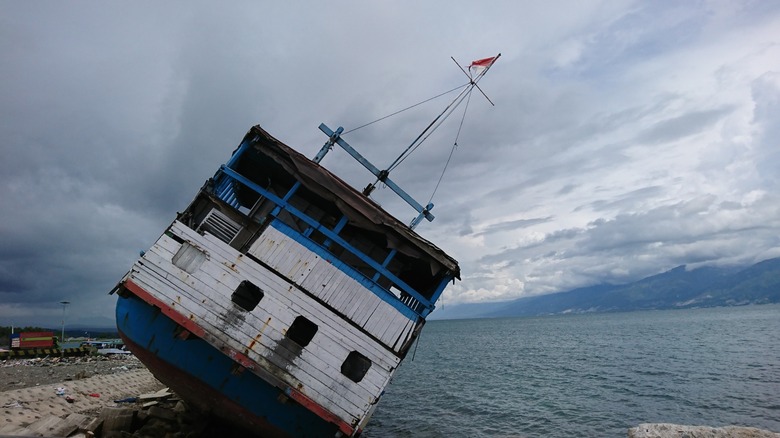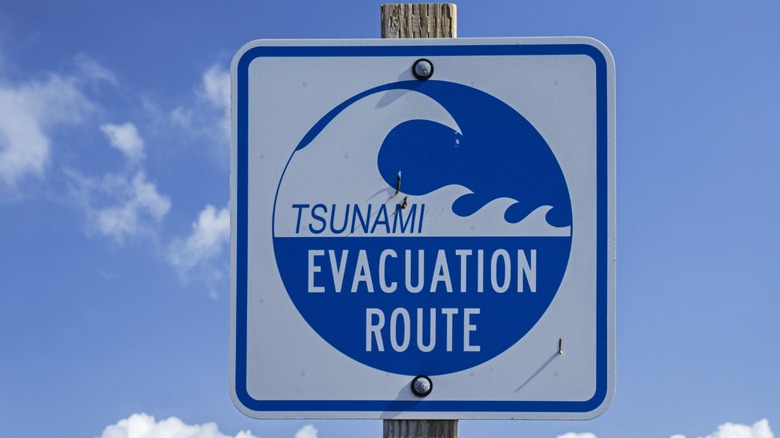Here's What Happens If Your Cruise Ship Is In Port During A Tsunami, And Why It's Better To Be At Sea
As worst nightmares on holidays go, being near a shore with an approaching tsunami tops the list. Luckily, serious tsunamis happen rarely, with those causing damage or death occurring about twice a year. About 80% of tsunamis develop along the Pacific Ocean's "Ring of Fire," and historically, Indonesia has experienced more than any other nation in the last 100 years. Heeding tsunami warnings is important, as they can travel up to at least 500 miles per hour, which means it's possible for the waves to cross the entire Pacific in less than a day.
In the harrowing event that you are on a cruise ship adventure and a tsunami warning is issued, you'll hope that the vessel is still at sea, rather than docked at port. That's because changes in water levels and unmoored debris can cause considerable damage to objects in a port — and that includes you. Don't freak out if you are already packing for a cruise, though, as there are ways to be safe in a disaster. Although it may be counterintuitive, experts recommend that boaters leave shore immediately and head out to sea after a tsunami warning. The Hawaii Boater's Hurricane and Tsunami Safety Manual recommends that vessels move to water that is at least 300 feet deep.
What happens to boats if they are in port when a tsunami hits
A common misconception is that tsunamis are one giant wave that crashes ashore. They actually consist of surges of water that sometimes reach over 100 feet. They're caused by earthquakes, volcanic eruptions, and, increasingly today, underwater landslides caused by melting glaciers. Water levels can rise and fall dramatically during a tsunami, which could be particularly unfortunate for boats that are tied to piers, as the fluctuations can dislodge them and cause collisions with other ships or structures. For boats and ships that remain in place, strong currents and floating debris are enough to cause them serious harm.
Tsunami waves are much lower in ocean depths greater than 180 feet, and although water levels still fluctuate, the changes are small enough to pass under cruise ships without incident. So, although there are reasons to avoid taking a cruise, cruise ships at sea are a fairly safe place to be in a tsunami. This is why cruise ships could disembark immediately after a tsunami warning, leaving some passengers behind. In July 2025, a Norwegian Cruise ship departed Hilo, Hawaii, two hours early due to a warning issued to the area. While this action caused some dismay, the decision was made to prioritize the safety of the crew and guests already on board, as explained by company officials.
Tsunami waves can continue from hours to days, and there's no way to predict intervals between surges. That's why it makes sense for cruise ships to head into deeper waters, delay returning to shore, or cancel port stops altogether until receiving the all-clear. Fortunately, cruise ship captains and crew members have emergency training. The ships are also connected to tsunami alert networks, so they'll know when it's safe to return to port.
What to do in the event you are on shore in a tsunami
If you can't make it back to your cruiseship in time and are stuck on the beach, there are some things to look out for. A good sign that a tsunami is on its way is a sudden rise or receding of ocean waters. To be doubly aware, you should pay attention to emergency information and alerts. Most importantly, though, do not wait to act. Evacuating areas near the beach right away can be the difference between life and death.
If an earthquake precedes the tsunami, there are some best safety practices, such as dropping to your hands and knees, finding cover for your head and neck, and holding on to any immovable objects until the earthquake abates. Then, get to as high ground as possible or as far inland as you can. If you find yourself in the water, try to get hold of a flotation device or something that naturally floats, such as a tree trunk. If you're navigating a boat you own, face the direction of the waves and head out to sea.
Tsunamis may be becoming more frequent due to climate change. If you live in an area that's particularly vulnerable, consider creating a family emergency plan in the event you are separated. Look out for national public alerts or emergency notices from officials.


